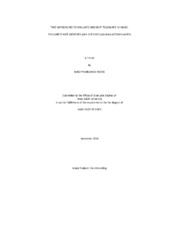| dc.description.abstract | We wanted to develop rapid and cost-effective drought tolerance screening methods for mass amounts of germplasm. In 2009 and 2010, we evaluated sixty-two maize inbred lines and their hybrid testcross progeny using seedling stress response and epicuticular wax accumulation as predictors of drought tolerance.
The seedling screening method measured germination, survival and recovery percentages after a series of drought cycles in a greenhouse environment. Eight inbred lines had significantly (P < 0.05) lower germination than the mean estimate, but hybrid testcrosses were not significantly different. The second-to-last day of survival cycle and the second day of recovery cycle best explained genotypic differences for inbred lines and hybrid testcrosses respectively. One inbred line performed well as both an inbred line and hybrid testcross, but poor correlation over the sample set (R2 = 0.0097) was observed.
Flag leaves taken at flowering from plants under full and limited irrigation regimes were sampled for epicuticular wax. Extracted wax weight for genotypes was compared as a percentage of leaf weight (percent wxlfwt) and leaf area (percent wxwta). Eleven genotypes had above average percent wxlfwt as both inbred lines and hybrid testcrosses. Thirteen genotypes had above average percent wxwta as either inbred lines or hybrid testcrosses. Irrigation treatment was not significant (P > 0.05). Heritability of percent wxlfwt was 0.17 (inbred lines) and 0.58 (hybrid testcrosses). Heritability of percent wxwta was 0.41 (inbred lines) and 0.59 (hybrid testcrosses). Correlations (R2) for percent wxlfwt and percent wxwta were 0.19 and 0.03, respectively. Heritability of grams of grain per ear and total grain yield was highest in hybrid testcrosses, with no correlation between inbreds and hybrids.
The developed seedling screening method easily allowed visible drought tolerance observations in inbred lines and hybrid testcrosses but does not seem heritable in our germplasm. Epicuticular wax weight is not an ideal primary trait to evaluate for drought tolerance, but may be a good candidate to observe as a secondary trait in relation to grain yield production in hybrids. Results from this research best supports breeder selection of hybrid germplasm using seedling drought tolerance in conjunction with epicuticular wax. | en |


